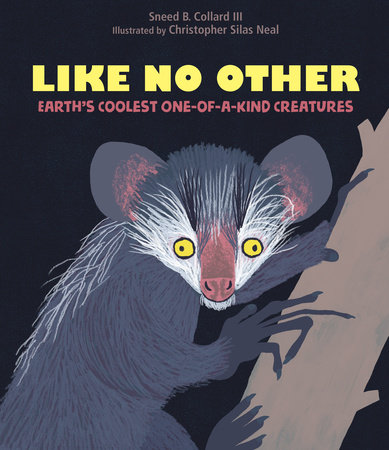LIKE NO OTHER Q&A with author Sneed B. Collard III and Editor Harold Underdown

Do you ever wonder how a book or a series came to be – the “story behind the story”? Take a glimpse behind the curtain with this fascinating chat between Kane Press executive editor Harold Underdown and author Sneed B. Collard III as they talk about the beginnings and inspiration behind Like No Other: Earth’s Coolest One-of-a-Kind Creatures.
HAROLD UNDERDOWN: How did you come up with the idea for Like No Other? Did it come to you fully formed, or did you have to explore it?
SNEED B. COLLARD III: My interest in one-of-a-kind animals began with my visit to New Zealand in 1988. Like most people, I was captivated by the interesting plants and animals in that country, which happened to break away from the ancient supercontinent of Gondwana at a critical point in the evolution of plants and animals.
One animal in particular, the tuatara, was the sole survivor of its once large order of reptiles Although the tuatara superficially looks like a lizard, it has several distinct anatomical features and has carved out a unique niche living with nesting seabirds in New Zealand’s cool climate. Over time, I kept coming across other fascinating animals that had no close living relatives. I pitched a book on all of these animals to Kane Press, and that got the ball rolling.
HU: What particularly interests you about the topic of animals “like no other”?
SC: One is that they often have unusual adaptations that are present in no other animals. The Aye-aye, for instance, uses its very long center finger to tap on tree trunks and branches, listening for any hollow spaces or noises that might betray hidden insect prey. It lives like a woodpecker, but happens to be a mammal.
Another thing that interests me is their history. What happened to their close relatives? Was their survival pure luck? Did the animals in the book happen to evolve adaptations that their close relatives did not? With the tuatara, New Zealand probably happened to drift away at just the right time to save its ancestors from predatory animals that were gobbling up or outcompeting the rest of its relatives. Scientists are still piecing together the histories of many of the other animals in the book.
HU: What was the most fascinating thing you discovered while doing the research for Like No Other?
SC: I never even knew that purple frogs existed before writing Like No Other. And then to learn that they stay underground for most of the year—and that their tadpoles cling to rocks in the fastest streams and waterfalls—well, that’s pretty mind-blowing. My favorite animal to learn about, though, may be the monito del monte.
I had heard about the monito del monte before, but didn’t realize it was such a cute little, mouse-like mammal. I also didn’t realize that it can slip into an instant form of hibernation when temperatures get too cold—or that scientists believe it plays a vital role in dispersing the seeds of many South American plants. Add that to the fact that it got “left behind” by its whole group of marsupial mammals when Antarctica crept away from South America, and you’re left with an incredible story—a story, ahem, like no other!
HU: Besides the tuatara, have you had any up-close-and-personal encounters with the animals in Like No Other?
SC: While visiting Australia years ago, I was hiking along a stream when I saw movement underwater. At first I thought it was a fish, but then I recognized the distinct form of a platypus! I never imagined I would get to see one in the wild, and it was remarkable how at home it seemed swimming along the bottom of the stream in search of food. I have also been fortunate to have personal encounters with leatherback sea turtles and, in my home state of Montana, pronghorns—usually as they go bounding off across the grasslands!
HU: You include humans in your “collection.” So, how do humans fit in?
SC: Ah, how don’t they fit in? For one thing, modern humans have until fairly recently shared the planet with other species of humans—species which are now extinct. Another thing is that we are the first species to be able to figure out the relationships between earth’s other species. With our big brains and scientific research and technology, we are able to untangle how a monarch butterfly, for instance, is related to a dung beetle.
On the “not so cool” side, humans are the first species that has had a major role in causing other species to go extinct. By learning about the animals in Like No Other, I hope readers also learn about things humans can do to reverse our harmful activities so that all species can flourish on this one special planet that we all share.
Like No Other is available now!
This fascinating look at thirteen unusual animals, many of them rare or endangered, introduces the remarkable world of monotypic animals—those without any close relatives.
One-of-a-kind animals can be as familiar as the platypus or as unfamiliar as the purple frog. These fascinating and mysterious species belong to an exclusive club of living things: those with no close living relatives, making them monotypic species. Meet more than a dozen of these creatures (including humans!), learn what makes them unique, and explore the relationships among species on the evolutionary tree.
Written by NCTE Orbis Pictus award-winning author Sneed B. Collard III, this fascinating nonfiction picture book is ideal for kids, teachers, and librarians and includes extensive back matter and activities.


